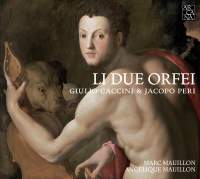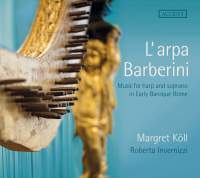Texte paru dans: / Appeared in:
|
|||||||
|
Outil de traduction (Très approximatif) |
|||||||
|
Reviewer:
David Vickers
Here are two dulcet albums by voice-harp duos exploring music from early-17th century Italy. Marc and Angélique Mauillon focus on the rival Florentine inventors of opera, Jacopo Peri and Giulio Caccini. We are treated to a diverse selection of their monodic songs in stile rappresentativo: a cultivated solo voice emulating the contours of Tuscan poetry, accompanied by a continuo instrument improvising over a written bass-line.
The Mauillons draw their selection from various collections all printed in Florence: Caccini’s Le nuove musiche (1602) is the best-known to posterity, and the Mauillons give a pleasingly natural rendition of the ubiquitous ‘Amarilli, mia bella’ (which every student of singing has been forced to learn for centuries). There are also songs taken from Caccini’s follow-up Nuove musiche e nuova maniera di scriverle (1614), and these clusters are interspersed with relatively fewer songs by Peri – some taken from La varie musiche (1609). Marc Mauillon’s ardently nuanced singing takes its cue directly from Caccini’s advice about sprezzatura, instructing that the singer must give intelligent performances with an appearance of ease. The intimacy and melancholic sensitivity of Peri’s ‘Tu dormi, e ’l dolce sonno’ (from a manuscript in the British Library) is aptly contrasted with livelier and more concise songs, such as Caccini’s ‘Odi, Euterpe’ (a witty portrait of an elated lover addressing his remarks to the Muse of Music). Angélique Mauillon accompanies exquisitely on a triple harp modelled after early-17th-century Italian instruments by the Somerset luthier Simon Capp. Margret Köll’s choice of harp is integral to the concept of ‘L’arpa Barberini’ – a famous triple harp built in about 1620 for the powerful Barberini family (not long before Bernini’s patron Cardinal Maffeo Barberini became Pope Urban VIII). Accent’s booklet contains several colour photographs of the ornately gilded and carved instrument, an X-ray image and a reproduction of Giovanni Lanfranco’s allegory of music that was painted for the Palazzo Barberini in the 1630s (and which features the harp at its forefront).
Köll’s hands
weave their magic on a modern replica that produces a beguiling dynamic range of
sonorities in a rippling toccata by Kapsberger and several pieces by Frescobaldi,
and her partnership with Roberta Invernizzi yields radiant performances of songs
by composers employed by the Barberini. Orazio Michi dell’Arpa (1594-1641), as
his nickname suggests, was a renowned harpist; Invernizzi’s account of a lover’s
plaint in ‘Spera mi disse amore’ has vivid emotional delivery, whereas the more
naive lover’s adoration in ‘Dolce frutto Amor compose’ is an ecstatic miniature.
There is also an enraptured performance of Luigi Rossi’s lament for Euridice
(‘Mio ben, teco il tormento più’), from his Paris opera L’Orfeo (1647) –
one doesn’t mind the tenuous connection to the Barberini harp when the
music-making is as gorgeous as this is. |
|||||||
|
|
|||||||
|
|
|
||||||
|
Cliquez l'un ou l'autre
bouton pour découvrir bien d'autres critiques de CD |
|||||||





